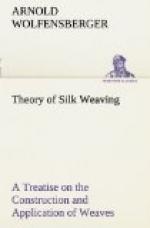A knowledge of the construction of weaves as explained in the foregoing chapters will enable us to determine the weave of a simple pattern by merely raising a warp-thread with a needle on any point of interlacing and counting off how many picks apart from this place it makes an impression.
2. LENGTH AND WIDTH OF THE FABRIC
To the length and width which the finished product is to have, we must add a certain allowance for shrinkage and taking up of warp during weaving. It may differ from one to ten per cent., according to the texture and weave of the fabric, and can be ascertained with sufficient accuracy by stretching out and measuring a thread of warp and filling and comparing their length with the respective measurements of the sample to be reproduced.
[Page 69] 3. THE STOCK AND ITS DYE
Under this heading we must give the particulars as to nature, twist, quality and size of the silk, and the directions for the dyeing, whether bright or souple, and in what colors, also whether to be weighted or not.
The size is generally ascertained (in practical work) by comparing it with other silk of which the exact count is known. Another method is to count the number of cocoon threads which a thread of the sample contains, adding to that 1/3 or 1/4, according to the quality of the silk; the result will be the count in deniers. To obtain it in drams, divide the latter number by 17,3 as 1 dram is equal to 17,3 deniers.
Suppose we find 20 cocoon ends in a thread of silk: add 1/3, and we have 26-2/3 deniers, which, divided by 17,3 make 1,54 drams.
As silk is always more or less uneven, it is safer to count the cocoon fibers of several threads and to take average thereof.
It requires the experience of years to judge with any degree of certainty as to the origin and quality of silk, whether it be “classical,” “extra,” “sublime,” etc.
There are machines wherewith to ascertain exactly the twist, that is, the number of turns the silk has received in the throwing process.
In the dyeing we distinguish two great classes, of which the names themselves give a good definition. “Bright” has a brilliant luster, while “souple” has more of a dull, subdued appearance. To find out whether the silk has been weighted in the dyeing process, we may compare it with other silk of which the exact conditions are known, or we may burn a small quantity of it. Unweighted silk does not burn readily and leaves a residue of white ashes, while heavy weighted silk burns lively, leaving black, charry ashes.
[Page 70] 4. REED CALCULATION
We count the number of repeats of the weave in a given space, generally 1/4 or 1/2 inch, and multiply this with the number of threads one repeat contains, which gives us the reduction of the warp.
Suppose we had a taffeta, which, as we know, has only 2 ends to a repeat, and counted 30 interlacings per 1/4 inch on one pick; we would have 60 threads per 1/4 inch or 240 per one inch. In this case the reed may be 80 by 3 or 60 by 4.




